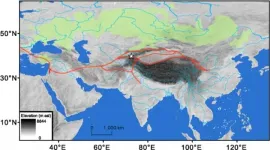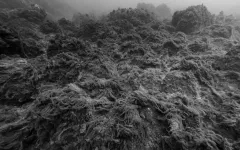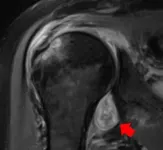(Press-News.org) The Silk Road was the most elaborate network of trade routes in the ancient world, linking ancient populations in East Asia to those in southwest Asia, via Central Asia. These trade routes fostered the spread of ideas, religions, and technologies over the past 2,000 years. Before the establishment of organized exchange, starting around the time of the Chinese Han Dynasty (2,223 years ago), a process of trans-Eurasian exchange was already underway through the river valleys and oases of Central Asia. The establishment of populations in the oases of the Taklimakan Desert in Xinjiang, China, was a major factor facilitating this trans-Eurasian exchange. However, archaeological evidence for human occupation in these arid regions as well as long-distance diffusion of cultural material is largely lacking prior to the early fourth millennium BP. Paleoecologists have long been aware of the potential for regional climatic fluctuations in Arid Central Asia (ACA), and the shifting oases or river ways of the desert zone can influence cultural diffusion along the pre-Silk Road.
In this publication, a team of paleoclimatologists provides evidence suggesting that an extended dry period may have made it more difficult to traverse these deserts for a 640-year period in prehistory. The megadrought in ACA appears to have occurred during 5820-5180 BP, and was likely tied into a northward shift in the prevailing air masses. The dearth of archaeological evidence for sedentary human occupation in the region during this drought period suggests that the climatic conditions may have hindered human movement and effectively reduced or blocked overland travel between eastern and western Central Asia. The agricultural regions of the ancient world were isolated from each other by the high peaks of the Himalaya, but exceptionally arid climatic conditions in Central Asia may have further contributed to that cultural isolation.
The results of this international research endeavor, led by Dr. Liangcheng Tan, a professor from The Belt & Road center of the Institute of Earth Environment, through the Chinese Academy of Sciences, were recently published in Science Bulletin as a cover paper. The article is titled "Megadrought and cultural exchange along the proto-Silk Road". The research team includes collaborations with 15 scientific institutions and universities from China, the United States, Kyrgyzstan, Germany, and the United Kingdom.
Archeological studies indicate that trans-Eurasian exchange was occurring as early as the terminal 5th millennium BP, but only started in earnest during the 4th millennium BP. This exchange is marked by the dispersal of wheat, barley, sheep, goats, and cattle from West Asia into northern China. Likewise, East Asian broomcorn and foxtail millet dispersed from northern China into West Asia, and eventually on to Europe. Some scholars have referred to this process as food globalization in prehistory. The traditional narrative suggest that early movements of humans crossed the northern Eurasian steppe. However, increasingly archaeologists are recognizing that the main routes of cultural dispersal in prehistory followed the same routes as the historic Silk Road. These river valleys and desert oases fostered connections between intensive agricultural regions in prehistory.
This international team worked in collaboration with officials in Kyrgyzstan to collect stalagmites from Talisman Cave. The cave is located in the southeastern Fergana Valley, near the crossroads of the historic Silk Road. Stalagmites are cave formations that gradually accumulate over thousands of years as water drips from the cave roof and calcium precipitates out of it. These features trap in their cores a highly detailed climatic record, unlike what can be pieced together through pollen or paleolake shore studies. The researchers on this project used oxygen and carbon isotopes, as well as trace element records to track precipitation changes through time. They also used a radiometric U-Th dating techniques on the two stalagmites to reveal precipitation (rainfall and snowfall) history in ACA over the past 7,800 years. The average dating uncertainty of this method is about 6‰, and average temporal resolution of the proxies is roughly 3 years. This nuanced level of precision allows for a high-resolution precipitation record.
The climatic record illustrated frequent short-duration shifts in the precipitation regimes for this intercontinental region. The most remarkable feature of the precipitation record was a prolonged period of aridity or a megadrought lasting 640 years, between 5820 and 5180 BP. The scale of the megadrought is unlike any of the other environmental shifts that the team noted for the last 7,800 years. This period of aridity would have had significant consequences in the local environment, especially in the ephemeral desert oases. For example, the level of Lake Balkhash was at least 20 meters lower during the peak of the megadrought than at present. The scientists suggest that the megadrought resulted from a northward shift of the westerly jet. As explained by Dr. Liangcheng Tan, "the northward shift of the westerly jet could have reduced the frequency and intensity of Mediterranean storms, decreasing precipitation in the Mediterranean and parts of southwest Asia, and reducing the moisture transfer to Arid Central Asia". In addition, it strengthened and shifted the westerlies northward, decreasing the sea surface temperature of the North Atlantic, and reducing the evaporated moisture transported from the North Atlantic to ACA. The two processes could have worked together and amplified the regional effects of the other, ultimately resulting in the megadrought.
The researchers further collected up-to-date archaeological records from across Eurasia over the past 10,000 years, and found a synchronous shift in the timing of the dispersal of cultural traits across East and West Asia. Agropastoral groups did not begin to expand into ACA until after the megadrought. "No society could overcome the severity of these conditions over such a long period and the archaeological record of the area falls largely silent during this period. This suggests societies in Arid Central Asia had to abandon life around oases and relocate to areas with mountains and run-off to the north and south for reliable supplies of water", said by Prof. John Dodson from University of Wollongong. The megadrought would have hindered human movement and effectively reduced or blocked overland travel between eastern and western Central Asia along the pre-Silk Road. Instead, it may have pushed human movements further north into the Eurasian Steppe or forest steppe, further resulting in the first trans-Eurasian movements of people along the southern Siberia Steppe during the 5th millennium BP.
After the megadrought, precipitation gradually increased and the oases recovered, allowing for a demographic expansion and the beginning of cultural dispersal across ACA. Meanwhile, the development of agricultural and herding techniques, the domestication of the horse and eventually the camel further increased the mobility of agropastoral groups, which facilitated the interconnection of East and West Asian peoples by the 4th millennium BP.
Dr. Guanghui Dong of Lanzhou University, one of the paper's coauthors, think this study reveals the underlying mechanism of the spatial-temporal transformation of the Bronze Age trans-Eurasian exchange from a climatic and environmental aspect, and provides support for a better understanding of the formation of the prehistoric Silk Road. "The unusual precipitation record identified in this study could also contribute to a better understanding of the centennial- to decadal-scale hydroclimate changes in ACA, as well as predicting the future precipitation trends in this ecologically vulnerable region", said Dr. Tan.
INFORMATION:
This research was funded by the National Key Research and Development Program of China (2018YFA0606400), the Strategic Priority Research Program of Chinese Academy of Sciences (XDB40000000), etc. It is a part of the "Belt & Road" project of Institute of Earth Environment, Chinese Academy of Sciences.
See the article: Liangcheng Tan, Guanghui Dong, Zhisheng An, R. Lawrence Edwards, Haiming Li, Dong Li, Robert Spengler, Yanjun Cai, Hai Cheng, Jianghu Lan, Rustam Orozbaev, Ruiliang Liu, Jianhui Chen, Hai Xu, Fahu Chen. "Megadrought and cultural exchange along the proto-Silk Road". Science Bulletin, 2021, 66(6): 603-611. doi:10.1016/j.scib.2020.10.011.
https://www.sciencedirect.com/science/article/pii/S2095927320306642
Cardiovascular system can be regarded as a mechanical system centered on the heart. Blood flow in the vascular system, hemodynamics factors within the vasculature contain wall shear stress, circumferential wall tensile stress and hydrostatic pressure. Mechanical forces play an important role in vasculature and circulation, such as rapid regulation of vascular wall elasticity, administration of vascular remodeling, and the formation of arteriosclerotic lesions. Stress stimulation within the physiological range enables cells in dynamic balance to maintain homeostasis of vascular morphology, structure and function. Inversely, abnormal stresses stimulation, such as low shear stress, disturbed shear stress and high tensile strain, can break this balance ...
More people than expected ended their own lives in 2020 in Japan, overturning a decadelong slow decline in the nation's annual number of suicides, according to a new analysis by public health experts at the University of Tokyo. The increase in suicides was especially pronounced among women younger than 30, potentially due to the COVID-19 pandemic's disproportionate effect on part-time and travel industry employees.
"This trend of increased suicides among young women and university and high school students is very different from before COVID-19. Before COVID-19, if suicides increased, we would expect more deaths of middle-aged men," said Dr. Haruka Sakamoto, an expert in public health at the University of Tokyo and first author of the research publication in the Journal of the ...
After seven years of intense research, a research group from Aarhus University has succeeded - through an interdisciplinary collaboration - in understanding why a very extended structure is important for an essential protein from the human immune system. The new results offer new opportunities for adjusting the activity of the immune system both up and down. Stimulation is interesting in relation to cancer treatment, while inhibition of the immune system is used in treatment of autoimmune diseases.
In our bloodstream and tissues, the complement system acts as one of the very first defense mechanisms against pathogenic organisms. When these are ...
People with asthma in the most deprived areas are 50% more likely to be admitted to hospital and to die from asthma compared with those in the least deprived areas, a new five-year study of over 100,000 people in Wales has revealed.
Those from more deprived backgrounds were also found to have a poor balance of essential asthma medications that help prevent asthma attacks.
The new research, published in the journal PLOS Medicine, was conducted by Swansea University's Wales Asthma Observatory in collaboration with Asthma UK Centre for Applied Research and Liverpool University, and found ...
SAN FRANCISCO, CA--February 16, 2021--In people with central nervous system (CNS) lymphoma, cancerous B cells--a type of white blood cell--accumulate to form tumors in the brain or spinal cord, often in close proximity to blood vessels. This disease is quite rare, but individuals who are affected have limited treatment options and often experience recurrence.
Previous research has linked the severity of CNS lymphoma to abnormal leaks in the blood-brain barrier, a protective system that allows some substances to pass from the bloodstream to the brain, while blocking others. However, the specific molecular details of this link have been murky.
Now, Gladstone researchers have ...
Tsukuba, Japan - It's tough out there in the sea, as the widespread loss of complex marine communities is testament to. Researchers from Japan have discovered that ocean acidification favors degraded turf algal systems over corals and other algae, thanks to the help of feedback loops.
In a study published this month in Communications Biology, researchers from the University of Tsukuba have revealed that ocean acidification and feedback loops stabilize degraded turf algal systems, limiting the recruitment of coral and other algae.
Oceans are undergoing widespread changes as a result of human activities. These changes take the form of regime shifts - major, sudden and persistent changes in ecosystem structure and function. An example is the replacement of coral reefs and kelp ...
An estimated 1.1 billion people were living with untreated vision impairment in 2020, but researchers say more than 90 per cent of vision loss could be prevented or treated with existing, highly cost-effective interventions.
Published today in The Lancet Global Health, a new commission report on global eye health calls for eye care to be included in mainstream health services and development policies. It argues that this is essential to achieve the WHO goal of Universal Health Coverage (UHC) and the 2030 United Nations Sustainable Development Goals (SDGs).
Written by 73 leading experts from 25 countries, including University of ...
FEBRUARY 15, 2021, NEW YORK - A Ludwig Cancer Research study has identified a novel mechanism by which a type of cancer immunotherapy known as CTLA-4 blockade can disable suppressive immune cells to aid the destruction of certain tumors. The tumors in question are relatively less reliant on burning sugar through a biochemical process known as glycolysis.
Researchers led by Taha Merghoub and Jedd Wolchok of the Ludwig Center at Memorial Sloan Kettering Cancer Center (MSK) and former postdoc Roberta Zappasodi--now at Weill Cornell Medicine--have discovered that in a mouse model of glycolysis-deficient tumors, CTLA-4 blockade does ...
Durham, NC- Can stem cells alleviate lymphedema, a chronic debilitating condition affecting up to one in three women treated for breast cancer? Results of a phase I clinical trial released today in STEM CELLS Translational Medicine (SCTM) show there is a strong possibility that the answer is yes.
Lymphedema is swelling due to a build-up of fluid in lymph nodes - vessels that help rid the body of toxins, waste, and other unwanted materials- usually occurring in an arm or leg. While it can be the result of an inherited condition, its most common cause in the Western world is the removal of or damage to the lymph nodes during the course of cancer ...
CHICAGO --- Muscle soreness and achy joints are common symptoms among COVID-19 patients. But for some people, symptoms are more severe, long lasting and even bizarre, including rheumatoid arthritis flares, autoimmune myositis or "COVID toes."
A new Northwestern Medicine study has, for the first time, confirmed and illustrated the causes of these symptoms through radiological imaging.
"We've realized that the COVID virus can trigger the body to attack itself in different ways, which may lead to rheumatological issues that require lifelong management," said corresponding author Dr. Swati Deshmukh.
The paper will be published Feb. 17 in the journal Skeletal Radiology. The study is a retrospective review of data from patients who presented to Northwestern Memorial Hospital between ...







